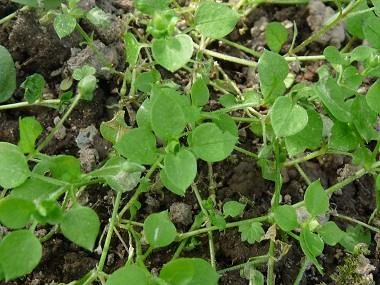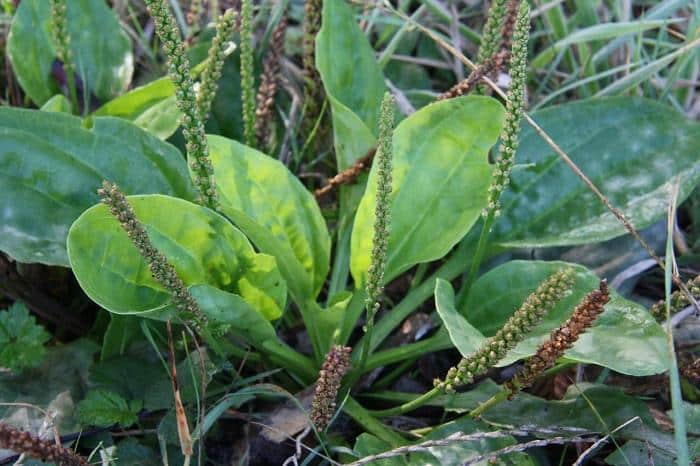
Did you know that some of the most common summer weeds and wild plants make great medicine?
Summer weeds soothe the itch of summer rashes, prevent the flu, relieve swelling, and more.
Some are simply packed with vitamins and minerals. Here are some of the best:
1. Plantain and Chickweed — The Soothing Duo
Plantain and chickweed are weeds which are commonly found growing in lawns. They are rich in nutrients and very emollient. Use them to soothe skin irritations and promote healing inside and out. I like to use them together; but use them separately if you desire.
Harvest the leaves of plantain. Both broad-leafed and narrow-leafed English plantain grow abundantly. Both kinds are useful, but the broad-leafed variety is often more abundant and contains more healing mucilage.
All of the above ground portions of chickweed are useful. Several species of chickweed grow throughout much of the world. All contain beneficial properties.
New “Survival Herb Bank” Gives You Access to God’s Amazing Medicine Chest
Plantain and chickweed are great plants to use for first aid. Simply crush whichever herb is handy and apply the herb directly to abrasions, minor scratches and rashes. This crushed herb preparation is known as an herbal poultice. The poultice will draw heat from inflamed tissues, resulting in less discomfort. Swelling, itchiness and the risk of infection decreases when an herbal poultice is applied. You may secure the poultice to an injury with gauze or clean cloth if needed.

Plantain seeds may be eaten or made into a tea to relieve irritation within the digestive tract or to relieve constipation. Plantain improves liver and gall bladder function.
Chickweed tea may be used as eyewash. It reduces bloating when drunk. Chickweed leaves make nutritious additions to salads and stir fries.
Plantain and Chickweed Oil
Chickweed and plantain are best used fresh or prepared as oils, salves or tinctures. One of the best ways to prepare plantain and chickweed is to make herbal oil. Pick the herbs. Let them wilt for an hour or so. Coarsely chop the herbs. Pack them tightly into a canning jar. Cover them with olive oil. The oil should cover the herbs by at least one inch. Run a knife through the blend to release any air bubbles. Cover the jar. Place it in a warm, sunny window for a couple of weeks. Shake the blend each day. After two weeks, carefully strain the oil from the herbs. Compost the herbs. The remaining rich oil may be applied topically to promote healing of skin wounds, infections and irritation.
Plantain and Chickweed Salve
Plantain and chickweed oil can easily be made into a convenient salve. It works especially well for preventing diaper rash, eczema and dermatitis.
Combine one cup of plantain and chickweed oil with ¼ cup of pure beeswax in a double boiler. Stir the blend until the wax is melted. Pour the blend in to sterilized containers, and cover them with tight fitting lids. I like to add several drops of pure vitamin E` before pouring the blend into individual containers. Vitamin E enhances the shelf life of the salve. One drop of lavender oil per container makes a nice addition as well.
2. Cleavers Reduce Swelling

Cleavers is another weed which contains healing properties. It relieves excess fluid from the body, making it a good remedy for PMS and occasional bloating. If bloating is persistent, see a health care practitioner for diagnosis and treatment. Cleavers may be added or substituted as an ingredient when making the plantain and chickweed salve. Internally, cleavers may be used as a tea to soothe swollen glands and sore throats. Use cleavers while it is fresh in order to reap the herb-healing properties.
3. Elderflowers are Useful Inside and Out
Dry some elder flowers now for winter use. They make mild-tasting herbal teas which help to prevent colds and flu. Much research substantiates elderflower’s abilities to reduce fever, discomfort and other symptoms of respiratory ills. You can also make syrup out of the flowers.
Elderflower Syrup for Colds and Flu
The easiest way to make syrup is to mix one ounce of fresh elderflowers with two cups of water in a pot. Apply a cover. Slowly simmer the herbs and water until only about one-half of a cup of liquid remains. Strain the flowers from the remaining tea. Squeeze the flowers in a piece of cheesecloth over the remaining tea. Strain the tea a second time. Stir in one-half cup of honey. Return the tea to a simmer. Pour into sterilized jars. Apply a tightly fitting cap to the jar. Store the syrup in a refrigerator. Use one or two teaspoons of syrup every two to four hours as needed.
Elderflower Skin Toner
To make an elderflower skin toner, simply cover fresh elderflowers with witch hazel extract. Apply a cover. Shake daily for two weeks. Strain out the flowers. Use it topically to tone the skin after cleansing.
A word of caution
Always be sure to gather weeds and wild herbs from non-toxic environments. Avoid gathering them near busy roads or from lawns which have been treated with chemicals. Use multiple methods of identifying the herbs.
What healing weeds do you use? Tell us in the comments section below.
Sign up for Off The Grid News’ weekly email and stay informed about the issues important to you










